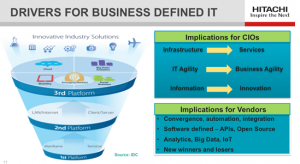Business Defined IT Will Drive the IT Trends in 2015
by Hu Yoshida, Vice President and Chief Technology Officer, Hitachi Data Systems
For the past several years I have published top ten IT trends for the coming year, based up on my observations of the current year. Next year the trends will be an extension of this year’s trends, but with more clarity and urgency. You have already seen disruption in the market place as vendors struggle to align with the changing demands of the business. For 2015 these trends will be driven by the need for IT to embrace the third platform that IDC has identified that is built on the mega trends around mobility, cloud, social and big data. I believe these are business trends that define IT and will be the bases for the major IT trends in 2015 and beyond.
Business Defined IT
Mobility, cloud, social, and Big Data are four macro trends that will drive sustainable business growth and will require stronger IT and business collaboration. Businesses need mobility for their people to be more productive in a competitive world. Businesses need the agility and elasticity of cloud for on demand services. Businesses need social to understand the sentiments of their customer base and connect with them on a more direct level. Businesses need Big Data for predictive analysis to guide their decisions and validate their assumptions. IT must respond to these requirements and become an architect and broker of business services rather than an administrator of data center infrastructure. In 2015 not only will you see CIO’s become more astute in regards to the business drivers around these trends; they will invest more of their budgets in business driven initiatives and businesses will control more of the IT spend.
In order for IT to focus more on business outcomes rather than infrastructure they will to need embrace technologies that converge, orchestrate, automate and integrate their infrastructure. Instead of a “Do IT Your Self” approach to building an application platform by connecting server, storage, network; orchestrating all the element managers; and integrating it with the operating system and application’s stack; they should be able to consume infrastructure like they buy a car, without having to build the car from scratch, starting with the wheels and the engine.
Business models for vendors and their channels are also being disrupted, and they are struggling to realign their portfolios. Amazon Cloud revenue was $2.6B in 2013 and displaced over $13B of IT spend that would have gone to traditional infrastructure vendors and their channels. Business defined IT will require Infrastructure vendors to provide more than just the infrastructure. They will need to provide orchestration, automation, and integration around their products to enable CIOs to focus on business outcomes. It is not enough for infrastructure vendors to build a bigger, faster, cheaper box. They must also provide the management and reporting software as well as services that support business defined IT. Since most IT organizations have not hired staff since 2008, they are over loaded with work and do not have the bandwidth to implement new software and processes. Vendors and their channel partners will need to provide services to offload some of this work and enable IT to transition to this new paradigm. Vendors and their channels must be willing to share the risk and work as partners with IT through this transformation.
